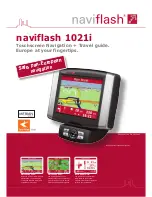
your position is our focus
2 Design-In
This
section
provides
a
Design-In
Checklist
as
well
as
Reference
Schematics
for
new
designs
with
LEA-4R/TIM-4R.
For
migration
of
existing
TIM-LR
product
designs
to
TIM-4R
please
refer
to
Appendix A
.
2.1 Schematic Design-In Checklist for LEA-4R/TIM-4R
Designing-in
a
LEA-4R/TIM-4R
GPS
receiver
is
easy,
especially
when
a
design
is
based
on
the
reference
design
in
Appendix C
.
Nonetheless,
it
pays
to
do
a
quick
sanity
check
of
the
design.
This
section
lists
the
most
important
items
for
a
simple
design
check.
The
Layout
Checklist
in
Section 2.4
also
helps
to
avoid
an
unnecessary
respin
of
the
PCB
and
helps
to
achieve
the
best
possible
performance.
!
Note
It’s
highly
recommended
to
follow
the
Design-In
Checklist
when
developing
any
ANTARIS
®
4
GPS
applications.
This
can
shorten
the
time
to
market
and
significantly
reduce
the
development
cost.
!
Note
For
important
information
explaining
the
various
aspects
of
this
checklist
see
section
3
in
the
Antaris
®
4
System Integration Manual [5]
Check Power Supply Requirements and Schematic:
Is
the
power
supply
within
the
specified
range?
Place
any
LDO
as
near
as
possible
to
the
VCC
pin
of
the
module;
if
this
is
not
possible
design
a
wide
power
track
or
even
a
power
plane
to
avoid
resistance
between
the
LDO/
power
source
and
the
GPS
Module.
Is
the
ripple
on
VCC
below
50mVpp?
Backup Battery
A
backup
battery
is
a
must
for
DR
enabled
GPS
receiver’s
designs.
Make
sure
to
connect
a
backup
battery
to
V_BAT
.
LEA-4R/TIM-4R
do
not
operate
without
a
backup
battery.
When
you
connect
the
backup
battery
for
the
first
time,
make
sure
VCC
is
on
or
–
if
not
possible
–
power
up
the
module
for
a
short
time
(e.g.
1s)
ASAP
in
order
to
avoid
excessive
battery
drain.
While
power
off,
make
sure
there
are
no
pull-up
or
down
resistors
connected
to
the
RxD1,
RxD2,
EXTINT0
and
EXTINT1
as
this
could
cause
significant
backup
or
sleep
current
(>25µA
or
more
instead
of
5µA).
Antenna
Active
antenna
is
supported.
The
total
noise
figure
should
be
well
below
3dB.
If
a
patch
antenna
is
the
preferred
antenna,
choose
a
patch
of
at
least
18x18mm
(25x25mm
is
even
better).
Make
sure
the
antenna
is
not
placed
close
to
noisy
parts
of
the
circuitry.
(e.g.
micro-controller,
display,
etc.)
For
active
antennas
add
a
10R
resistor
in
front
of
V_ANT
input
for
short
circuit
protection
or
use
the
antenna
supervisor
circuitry.
When
migrating
from
TIM-LR
reduce
R5
of
the
Antenna
Short
and
Open
Supervisor
circuit
to
18k.
Adapt
the
value
of
some
of
the
resistors
in
the
reference
design
to
the
3.0
V
voltage
levels
(see
Appendix C).
Serial Communication
Choose
UBX
for
an
efficient
(binary)
data
handling
or
if
more
data
is
required
than
supported
by
NMEA.
When
using
UBX
protocol,
check
if
the
UBX
quality
flags
(see
Section
4.1.9.2
)
are
used
properly.
Customize
the
NMEA
output
if
required
(e.g.
NMEA
version
2.3
or
2.1,
number
of
digits,
output
filters
etc.)
LEA-4R
/
TIM-4R
-
System
Integration
Manual
/
Reference
Design
Design-In
GPS.G4-MS4-05043
Page 10










































